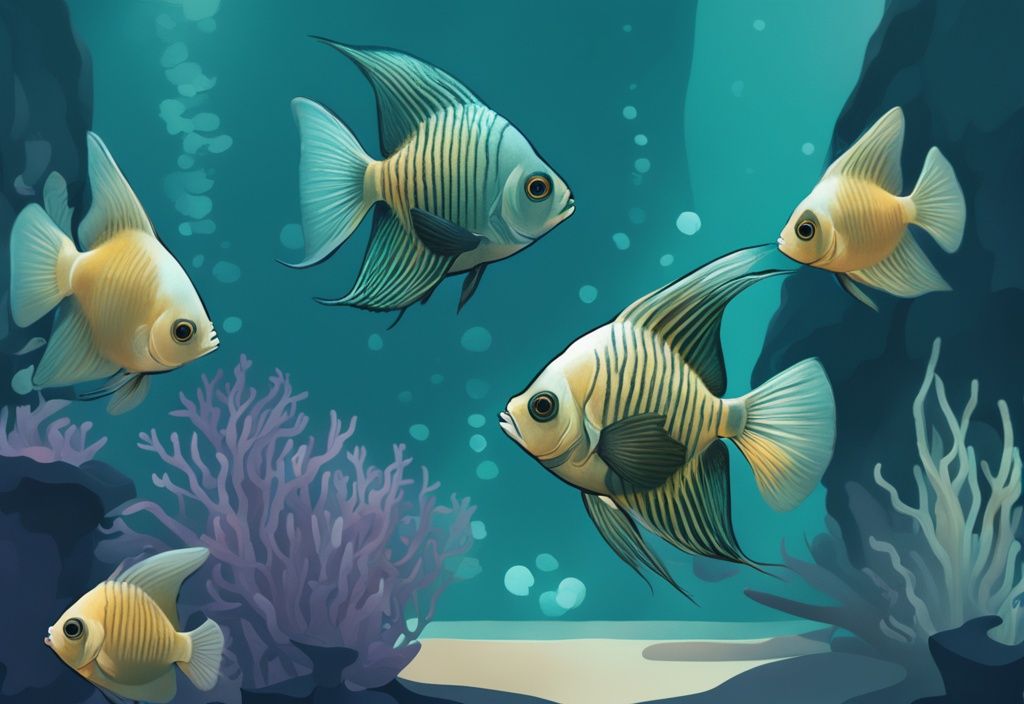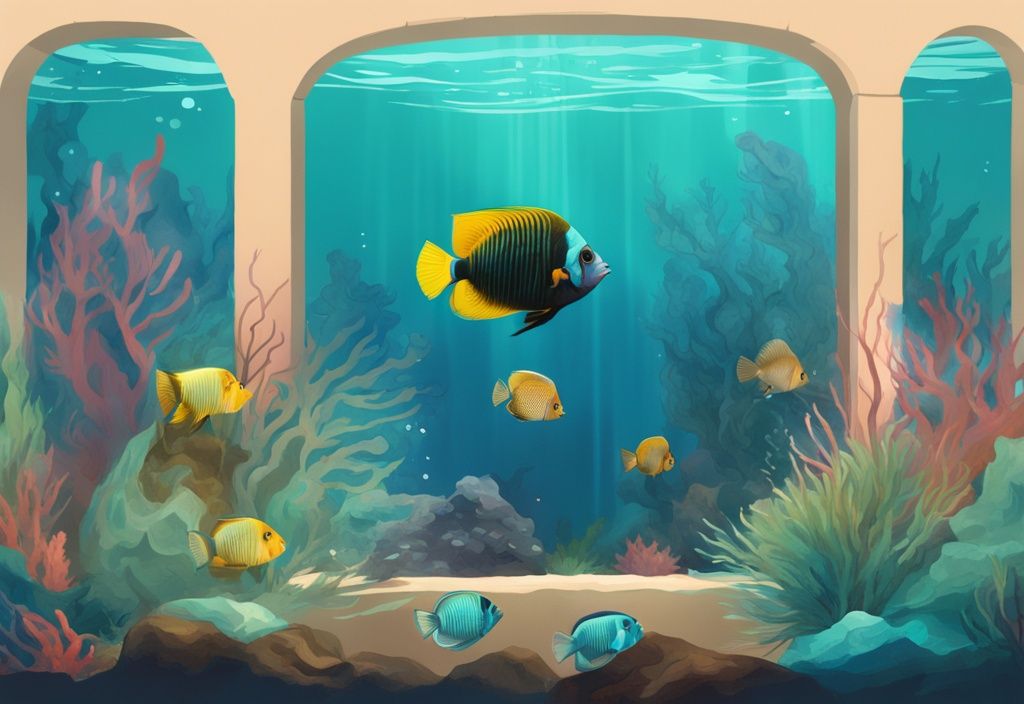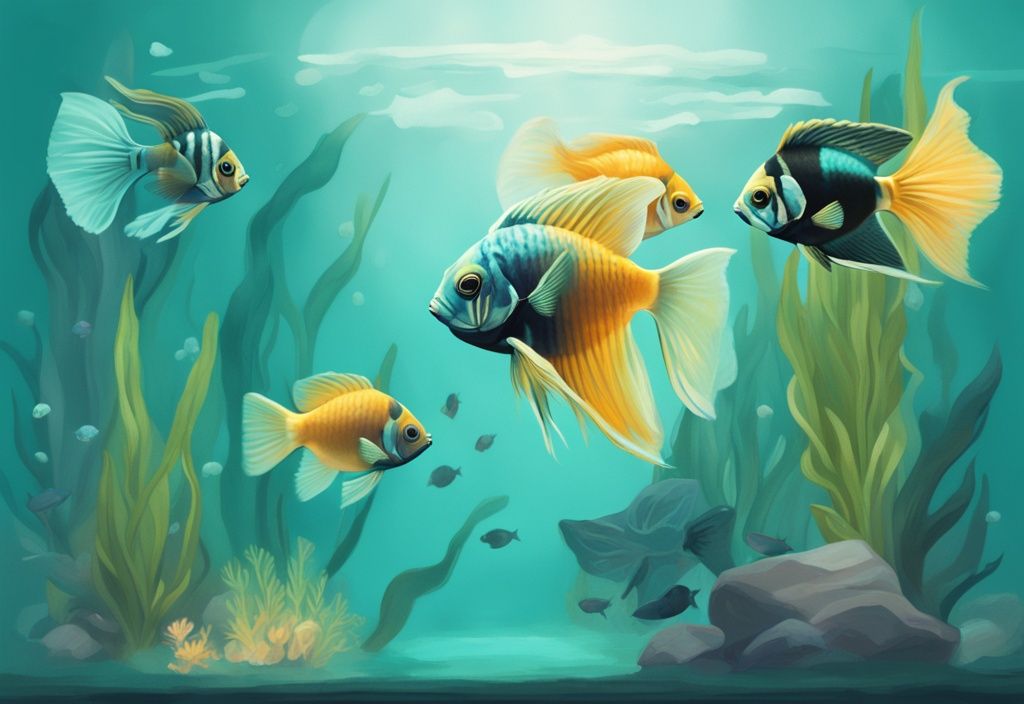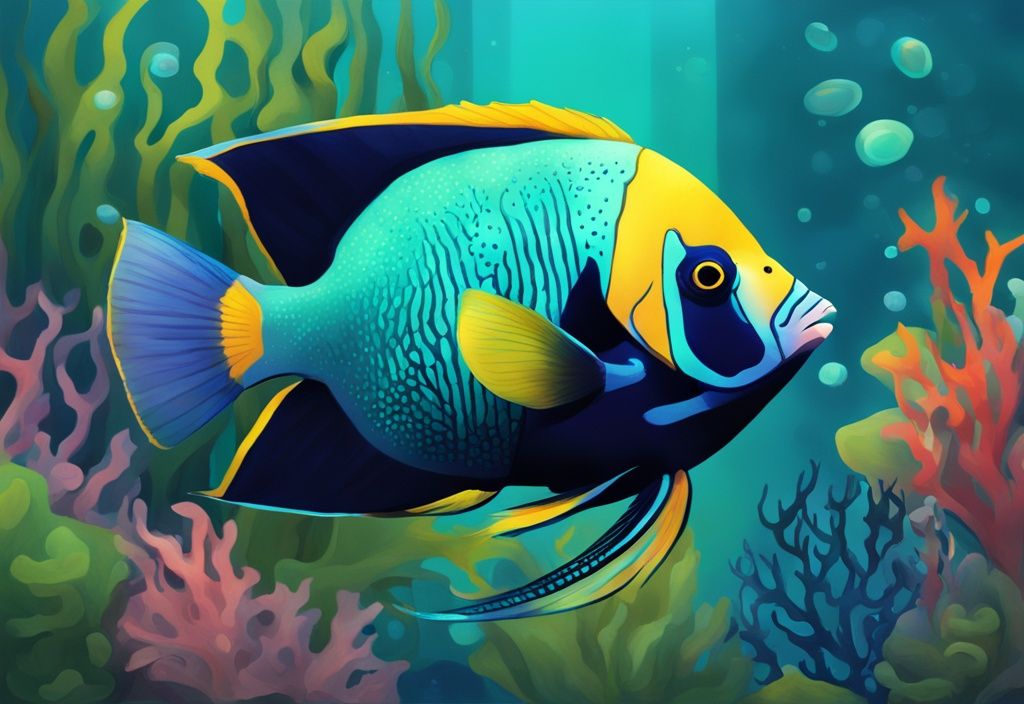Have you ever witnessed a battle royale in your aquarium due to incompatible fish? Well, matching angelfish with the right tank mates is more than random guessing. It’s a delicate science that you must get right to create a peaceful aquatic environment.
In this comprehensive guide, you’ll gain insights into the behavioral nuances of angelfish and learn which fish breeds can live harmoniously with them. We’ll also address commonly faced compatibility issues, and provide solutions to ensure your fish tank is a thriving ecosystem rather than a battleground.
As an expert marine biologist, I’ve married science with experience to create a practical roadmap that pulls you away from fish warfare. So, let’s embark on this journey together, and transform your angelfish aquarium into a tranquil aquatic paradise.
Understanding the Behavior of Angelfish for Compatibility
When it comes to ensuring your angelfish coexist peacefully with their tank mates, it’s vital to delve into their unique behaviors and personality traits. Angelfish exhibit distinct behavioral patterns during feeding and breeding times, and understanding these can help you create a more harmonious aquarium environment.
The Temperament of Angelfish
Angelfish, with their striking appearance, are generally known for their peaceful nature. However, they can become territorial and aggressive, particularly during feeding and breeding times. Factors such as tank overcrowding and the availability of hiding spaces significantly influence their temperament. Overcrowding may exacerbate their territorial instincts, while providing ample hiding spots can offer retreats that reduce stress.
To foster a harmonious coexistence, it’s critical to recognize that angelfish establish territories, especially around potential nesting sites. Understanding these behaviors allows you to manage tank dynamics more effectively, as highlighted in research on the influence of social rank in the angelfish, Pterophyllum scalare, on locomotor and feeding activities in a novel environment (The influence of social rank in the angelfish, Pterophyllum scalare). By strategically arranging the tank environment, you can minimize conflicts, ensuring a tranquil community setting.
Typical Behavior During Feeding and Breeding
Feeding times can trigger competitive and dominant behaviors in angelfish. This heightened assertiveness can create stress for more timid tank mates, making it difficult for them to access food. A practical solution is to create multiple feeding zones. This strategy ensures all fish receive adequate nourishment without being outcompeted.
Breeding periods present another challenge. Angelfish become fiercely protective of their nesting sites and eggs, exhibiting increased aggression to safeguard their offspring. To manage this, provide ample space and hiding spots within the tank. These provisions allow other fish to find refuge, reducing direct conflicts and maintaining a balanced environment during these critical times.
Exploring Suitable Angelfish Tank Mates
To maintain a serene and balanced aquatic environment in your angelfish tank, selecting compatible tank mates is crucial. Here are detailed recommendations and considerations for choosing the best companions for your angelfish.
Compatible Fish Species for Angelfish Tanks
Angelfish can thrive alongside various compatible species, enhancing the harmony of your aquarium. Consider these options:
- Gouramis: Peaceful and similar in size to angelfish, Gouramis are excellent tank mates. Their gentle nature and resilience ensure smooth coexistence.
- Pictus Catfish: Bottom dwellers like Pictus Catfish steer clear of the angelfish’s swimming zones, minimizing the risk of aggressive encounters.
- Plecos or Suckermouth Catfish: Known for their cleaning abilities, these catfish are non-threatening to angelfish and help maintain a spotless environment.
- Mollies: Generally peaceful, Mollies adapt well to similar water conditions, making them suitable companions in a community setup.
- Dwarf Cichlids: Species like Bolivian Rams are assertive yet peaceful, ensuring harmony without causing stress.
- Black Skirt Tetra: Their larger size prevents them from becoming prey while maintaining a peaceful demeanor.
- Marbled Hatchetfish: These top-layer dwellers avoid the angelfish’s territory, reducing territorial conflicts.
- Bristlenose Pleco: Excellent bottom dwellers, Bristlenose Plecos are non-invasive and contribute to keeping the tank clean.
- Pencilfish: These top-layer schooling fish are too large for angelfish to eat when mature, ensuring stress-free cohabitation.
- Corydoras Catfish: Hardy and peaceful, Corydoras Catfish occupy the bottom of the tank, steering clear of angelfish territory and ensuring compatibility.
Reasons to Choose Certain Tank Mates
Selecting the right tank mates for angelfish involves considering multiple factors to ensure a harmonious living environment.
Size Compatibility: Tank mates should be large enough not to be seen as food by angelfish. This precaution minimizes predatory behavior, ensuring the smaller fish do not become a meal. Suitable species include Black Skirt Tetras and Gouramis, which are large enough to coexist peacefully.
Peaceful Nature: Ideal tank mates are generally peaceful and non-aggressive, maintaining the overall harmony of the aquarium. For optimal water movement and to maintain a healthy environment, consider investing in the best aquarium wave maker. Fish such as Mollies and Dwarf Cichlids like Bolivian Rams exhibit calm demeanors, promoting a stress-free environment.

Different Tank Zones: Fish that occupy different areas of the tank help reduce territorial disputes. For example, bottom dwellers like Pictus Catfish and Corydoras Catfish, as well as top-layer swimmers like Marbled Hatchetfish, naturally stay away from the angelfish’s preferred middle zone, minimizing conflict.
Complementary Water Conditions: Ensuring that all tank mates thrive under similar water parameters is crucial for their health and compatibility. Fish such as Plecos and Suckermouth Catfish, which share similar temperature and pH preferences with angelfish, help create a stable and thriving aquarium ecosystem.
Factors to Consider for Angelfish Compatibility
Size and Temperament of Potential Tank Mates
Selecting the right angelfish tank mates demands keen attention to the size and temperament of potential companions. Angelfish, while generally peaceful, can exhibit aggressive behaviors, particularly towards smaller or overly docile fish—often during feeding times or territorial disputes.
This means it’s crucial to choose tank mates that are large enough not to be mistaken for prey and resilient enough to coexist in harmony. Fish that are too small might end up as targets, while timid species could be bullied or outcompeted for resources, leading to stress and potential health issues.
Opting for similarly sized tank mates with calm, non-aggressive demeanors is key. This helps create a balanced and peaceful environment in your aquarium, ensuring all inhabitants thrive together.
Important Water Conditions for Compatibility
Maintaining the ideal water conditions is foundational for the well-being of angelfish and their companions. The optimal temperature range for an angelfish tank falls between 78 to 82 degrees Fahrenheit, which significantly supports their health and reduces stress.
Stable pH levels and appropriate water hardness are equally essential, as they create a suitable habitat for both angelfish and their tank mates. Regular water changes and thorough cleaning are critical practices that maintain water quality, reducing stress and preventing disease onset.
Constant monitoring and diligent maintenance of your aquatic environment are foundational steps to promote compatibility among angelfish tank mates, fostering a balanced and healthy home for all.
Feeding Compatibility and Dietary Requirements
Ensuring that all fish in a mixed-species tank receive adequate nutrition is fundamental. Successful cohabitation with angelfish requires strategic diversification of feeding areas within your tank. This approach minimizes confrontations by preventing angelfish from dominating feeding zones.
It’s important to provide a variety of foods that meet the specific dietary requirements of all species in your tank. Balanced diets that cater to the nutritional needs of each type of fish promote overall health and vitality.
With thoughtful feeding strategies, you can sustain a harmonious community tank where all angelfish tank mates thrive peacefully, creating a vibrant and cohesive aquatic ecosystem.
Fish Species Incompatible with Angelfish
Maintaining a harmonious angelfish tank involves selecting appropriate tank mates, but some species are inherently incompatible due to their behavior, size, or environmental needs. Understanding these incompatibilities can help you avoid common pitfalls.
Fish Species that Cause Conflict in Angelfish Tanks
Fin-Nipping Species:
Fish like barbs and bettas are known for their fin-nipping tendencies. These aggressive behaviors can stress angelfish, leading to health issues and increased aggression in return. Barbs, with their erratic swimming patterns and penchant for nipping at trailing fins, pose a significant threat to the serene environment angelfish prefer.
Aggressive or Hyperactive Fish:
Tiger barbs, silver dollars, and Rift Lake cichlids exhibit aggressive or highly active behavior, creating a chaotic environment unsuitable for angelfish. These species often dominate feeding times and bully more passive tank mates, leading to significant stress and potential physical harm for angelfish.
Smaller Fish:
Neon tetras and other small species are easily seen as prey by angelfish. Their diminutive size makes them vulnerable, and the presence of predatory behavior from angelfish can lead to a decrease in the tetra population. This dynamic disrupts the balance of the tank’s community, introducing stress and predation.

Invertebrates:
Crabs, shrimp, and other invertebrates often become targets for angelfish. Angelfish may view these smaller, defenseless creatures as easy food, attacking and eating them. This behavior not only reduces the invertebrate population but also disrupts the ecosystem balance within the tank.
Goldfish:
Although goldfish are popular in home aquariums, they require different water temperatures than angelfish, which can lead to poor health for both species. Additionally, goldfish produce more waste, which can contaminate the tank, deteriorating water quality and creating a stressful environment for angelfish.
Large, Aggressive Species:
Oscars and piranhas are large, territorial fish that exhibit extreme aggression. Their size and temperament make them incompatible with the more peaceful angelfish, often resulting in violent confrontations. Such interactions can cause severe injuries or even death, making it imperative to keep these species separate from angelfish.
Selecting the right tank mates for angelfish involves careful consideration of each species’ behavior, size, and environmental needs. Avoiding inherently incompatible species ensures a peaceful, thriving aquatic community, providing a safer and healthier habitat for your angelfish.
Successful Introduction of New Tank Mates
The Importance of Gradual Introduction to the Tank
Introducing new fish into an established tank should be a gradual process to prevent stress and aggression among angel fish tank mates. Start with a quarantine tank to isolate new arrivals for a few weeks. This crucial step lets you monitor them for any signs of illness, ensuring they’re healthy before they join the community.
The key to a smooth integration lies in acclimation. Gradually mix the main tank water with the quarantine tank water over several hours. This careful process helps the new fish adjust to the temperature, pH, and hardness levels of your main aquarium, significantly reducing shock and stress.
Monitoring New Fish Behavior and Health
Once the new fish are in the main tank, keep a close eye on their behavior and interactions with the existing angel fish tank mates. Watch for stress indicators like constant hiding or refusal to eat. Also, be aware of any signs of aggression, whether from the newcomers or the established residents.
Vigilance is essential. Regularly check the physical health of all fish, looking for injuries, torn fins, or unusual activity. If any fish seem stressed or if aggressive behaviors continue, be prepared to separate them to prevent harm. Proper monitoring ensures a peaceful and healthy environment for all your tank inhabitants.
Recognizing and Addressing Compatibility Issues
Understanding and resolving compatibility problems in your angelfish tank is pivotal for maintaining a harmonious aquatic environment. Compatibility issues often manifest through various signs and require prompt action to prevent serious consequences.
Common Signs of Incompatibility in the Tank
Angelfish tanks can present compatibility challenges, and recognizing these issues early is crucial. Persistent hiding by any fish is a significant red flag, indicating stress or fear possibly due to another aggressive tank mate.
Another clear sign of incompatibility is visible injuries or torn fins, which suggest ongoing fights and physical altercations. Additionally, if one species monopolizes food resources, it can lead to starvation among other tank mates, disrupting the tank’s balance and leading to health issues.

Steps to Take When Compatibility Issues Arise
When you notice signs of aggression or incompatibility in your angelfish tank, immediate action is required to restore peace. If aggressive behavior continues despite initial adjustments, rehoming the problematic fish might be necessary.
Providing additional hiding spaces can also help reduce conflict by giving fish more territories to claim and retreat to.
It’s crucial to monitor water conditions rigorously, as stress from poor quality water can exacerbate aggressive tendencies. Consulting a professional or experienced aquarist can provide valuable insights and solutions tailored to your specific situation, ensuring a harmonious environment for all angelfish tank mates.
FAQ: Angel Fish Tank Mates
What Are the Best Tank Mates for Angelfish?
Choosing the right tank mates for your angelfish is crucial for a harmonious aquarium. Below are some of the best companions:
- Black Skirt Tetra: Large enough to avoid becoming prey and generally peaceful, making them a safe choice.
- Marbled Hatchetfish: These fish occupy the top layer of the tank, reducing the chances of territorial conflicts.
- Bristlenose Pleco: Excellent bottom dwellers that are non-invasive and help clean the tank, promoting a healthier environment.
- Pencilfish: As top-layer schooling fish, they grow too large for angelfish to target when mature.
- Corydoras Catfish: Hardy bottom dwellers that typically avoid confrontations, making them ideal companions for angelfish.
- Bolivian Ram: Assertive yet peaceful, these fish mesh well with the temperament of angelfish.
Can Angelfish Live Harmoniously with Tetras?
Yes, but it’s important to choose medium to larger tetras like Black Skirt Tetras. These tetras are too large to be preyed upon by angelfish, ensuring a peaceful coexistence. However, smaller species such as neon tetras may unfortunately become targets for angelfish.
How to Minimize Aggression in an Angelfish Tank?
To minimize aggression, ensure ample space and provide plenty of hiding spots to reduce territorial disputes. Maintaining optimal water conditions is crucial to keep stress levels low. Gradually introduce new tank mates, and closely monitor their interactions during the acclimation phase to ensure harmony.
Can Shrimp Coexist in an Angelfish Tank?
Generally, keeping shrimp with angelfish is not recommended as the shrimp may be preyed upon. If you choose to try it, opt for larger, more robust shrimp species. Additionally, ensure the tank has plenty of hiding areas to give the shrimp a chance to escape predation.
What’s the Ideal Tank Size for Angelfish and Their Mates?
A minimum of 20 gallons is recommended for a pair of angelfish, and additional space is required for each extra fish. Larger tanks help reduce stress and provide ample room for territories and hiding spots, promoting a peaceful environment for all inhabitants.
Conclusion
Choosing suitable angel fish tank mates goes beyond mere selection; it requires a deep understanding of their behavior patterns, ensuring the compatibility of different species, and maintaining optimal tank conditions. Angelfish are known for their complex temperament, which can range from peaceful to occasionally aggressive, particularly during feeding and breeding times. Thus, selecting the right tank mates involves prioritizing species that are peaceful and of an appropriate size to prevent them from becoming prey.
Compatibility isn’t only about temperament; it’s also highly influenced by the physical environment of the tank. Overcrowded tanks or insufficient hiding spaces can escalate territorial disputes, making the tank inhospitable for angelfish and their mates. Therefore, creating a well-structured habitat with ample space and hiding spots is crucial. This not only helps in reducing stress but also provides a refuge for more timid species.
Regular monitoring is an essential practice to ensure harmonious living conditions in an angelfish tank. Observing interactions between fish can help in early detection of any signs of stress or aggression, allowing aquarists to take timely action. If issues arise, it might be necessary to rehome certain fish or modify the tank layout to diffuse tension.
A gradual introduction of new tank mates can significantly smooth the transition period. Quarantining new arrivals not only ensures they are free from diseases but also allows them to acclimate to the tank’s water conditions. This step-by-step integration helps angelfish and new mates to get accustomed to each other in a less threatening environment.
In summary, by continuously monitoring and adjusting the tank environment, and carefully selecting and integrating angel fish tank mates, aquarists can create a thriving and serene aquatic habitat. The key to a successful angelfish community lies in the balance of understanding species compatibility, providing a conducive environment, and proactive management.
